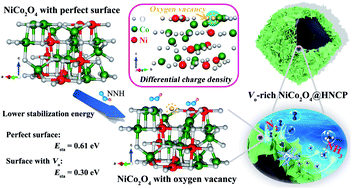Oxygen vacancy engineering in spinel-structured nanosheet wrapped hollow polyhedra for electrochemical nitrogen fixation under ambient conditions†
Abstract
Electrochemical nitrogen-to-ammonia conversion by the nitrogen reduction reaction (NRR) under ambient conditions is regarded as a potential approach to tackle the energy-intensive Haber–Bosch process with excessive CO2 emission. However, the NRR is still restricted by low faradaic efficiency and NH3 yield, which is due to the chemical inertness of N-related groups for efficient adsorption/activation on the electrocatalysts. Here, a series of spinel-structured nanosheet wrapped hollow nitrogen-doped carbon polyhedra with abundant oxygen vacancies are constructed successfully. From theoretical aspects, these materials show increased charge density on their surface for enhanced capture and activation of N2 molecules. As a result, oxygen vacancy-rich NiCo2O4 on hollow N-carbon polyhedra (Vo-rich NiCo2O4@HNCP) shows outstanding electrocatalytic NRR performance with high production yield (NH3: 4.1 μg h−1 cm−2/17.8 μg h−1 mg−1; faradaic efficiency: 5.3%) and high stability under ambient conditions and is superior to the counterpart oxygen vacancy-poor electrocatalysts. Oxygen vacancy engineering introduces a new concept for rational design of advanced NRR catalysts for energy conversion systems.



 Please wait while we load your content...
Please wait while we load your content...